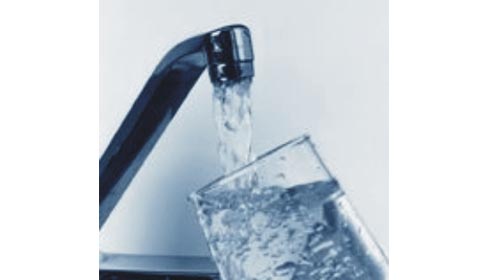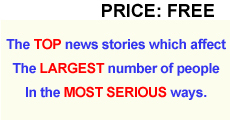 *17 percent of humanity without access to clean water, that’s more than 1.1 BILLION people, and this has nothing to do with water scarcity. There is plenty to go around.
*17 percent of humanity without access to clean water, that’s more than 1.1 BILLION people, and this has nothing to do with water scarcity. There is plenty to go around.
WHAT DOES IT MEAN “NOT HAVING ACCESS TO CLEAN WATER”?
“Not having access” to water and sanitation is a polite euphemism for a form of deprivation that threatens life, destroys opportunity and undermines human dignity. Being without access to water means that people resort to ditches, rivers and lakes polluted with human or animal excrement or used by animals. It also means not having sufficient water to meet even the most basic human needs.”
-Page 5 of the United Nations’ Human Development Report 2006, Beyond Scarcity: Power, Poverty and the Global Water Crisis at
http://hdr.undp.org/en/media/hdr06-complete.pdf
It’s “a euphemism for profound deprivation. It means that people live more than 1 kilometre from the nearest safe water source and that they collect water from drains, ditches or streams that might be infected with pathogens and bacteria that can cause severe illness and death”.
Page 33 of the United Nations’ Human Development Report 2006, Beyond Scarcity: Power, Poverty and the Global Water Crisis at
http://hdr.undp.org/en/media/hdr06-complete.pdf
17 PERCENT OF HUMANITY WITHOUT ACCESS TO CLEAN WATER !!
17 Percent of the World’s Population does not have sustainable access to an improved water source, per the chart on 308 of the Human Development Report 2006, Beyond Scarcity: Power, Poverty and the Global Water Crisis at
http://hdr.undp.org/en/media/hdr06-complete.pdf
“For some 1.1 billion people, sufficient, safe, acceptable, accessible and affordable water for life is a hope for the future, not a reality for the present.”
Page 77 of the United Nations’ Human Development Report 2006, Beyond Scarcity: Power, Poverty and the Global Water Crisis at
http://hdr.undp.org/en/media/hdr06-complete.pdf
WOMEN & WATER
Is the following one of the most ridiculous things you’ve heard of in the 21st Century?
“Women bear the brunt of responsibility for collecting water, often spending up to 4 hours a day walking, waiting in queues and carrying water.”
Page 23 of the Human Development Report 2006,Beyond Scarcity: Power, Poverty and the Global Water Crisis at
http://hdr.undp.org/en/media/hdr06-complete.pdf
WOMEN & SANITATION
In addition to not having water access to safe water for drinking or washing, 41 percent of humanity shit in the streets because they don’t have access to toilets or other sanitation facilities. (See the front page article “What A Shitty Way To Die! here.) But with respect to Women & Sanitation note that:
“Cultural norms strictly require that women not be seen defecating – a requirement that forces them to leave home before dawn or after nightfall to maintain privacy. As one woman in Bangladesh put it. ‘Men can answer the call of nature anytime they want . . . but women have to wait until darkness, no matter what problem she has’. Delaying bodily functions is a major cause of liver infection and acute constipation in many countries.”
-Page 48 of the Human Development Report 2006,Beyond Scarcity: Power, Poverty and the Global Water Crisis at
http://hdr.undp.org/en/media/hdr06-complete.pdf
THE ANGUISH AND SUFFERING CAUSED BY UNSAFE WATER IS “BEYOND ESTIMATION”
“Water-related illness accounts for about 5% of the global burden of disease. The anguish and suffering associated with that burden are beyond estimation.”
-Page 46 of the Human Development Report 2006,Beyond Scarcity: Power, Poverty and the Global Water Crisis at
http://hdr.undp.org/en/media/hdr06-complete.pdf
The water disease, Trachoma, for just one example, can make a person feel like their eyelids are being bitten by a dog or being scratched by a thorn that just cannot be removed, and is estimated to have already caused almost 6 million people to become needlessly blind.
Page 46 of the United Nations’ report Human Development Report 2006, Beyond Scarcity: Power, Poverty and the Global Water Crisis at
http://hdr.undp.org/en/media/hdr06-complete.pdf
lists the above and other examples of water-related illnesses and the death and suffering they cause.
BUT THERE’S ENOUGH WATER IN THE WORLD FOR EVERYONE!
“[T]here is more than enough water to go around and meet all of humanity’s needs.”
-Page 13 of the Human Development Report 2006,Beyond Scarcity: Power, Poverty and the Global Water Crisis at
http://hdr.undp.org/en/media/hdr06-complete.pdf
“The world has the technology, the finance and the human capacity to remove the blight of water insecurity from millions of lives”.
-Page 28 of the Human Development Report 2006,Beyond Scarcity: Power, Poverty and the Global Water Crisis at
http://hdr.undp.org/en/media/hdr06-complete.pdf
“Of course, water consumption in rich countries does not diminish water availability in poor countries. Global consumption is not a zero-sum game in which one country gets less if another gets more.”
-Page 35 of the Human Development Report 2006,Beyond Scarcity: Power, Poverty and the Global Water Crisis at
http://hdr.undp.org/en/media/hdr06-complete.pdf
“Globally, there is more than enough water for domestic purposes, for agriculture, and for industry.” –P. 123 of World Bank’s 2007 World Development Indicators report athttp://tinyurl.com/2epton
“At the start of the 21st century we have the finance, technology and capacity to consign the water and sanitation crisis to history just as surely as today’s rich counties did a century ago.”
-Page VI in Foreword of the Human Development Report 2006, Beyond Scarcity: Power, Poverty and the Global Water Crisis at
http://hdr.undp.org/en/media/hdr06-complete.pdf
“There is more than enough water in the world for domestic purposes, for agriculture and for industry. The problem is that some people – notably the poor – are systematically excluded from access by their poverty, by their limited legal rights or by public policies that limit access to the infrastructures that provide water for life and for livelihoods.”
-Page 3 of the Human Development Report 2006,Beyond Scarcity: Power, Poverty and the Global Water Crisis at
http://hdr.undp.org/en/media/hdr06-complete.pdf
The United Nations calls their current phony bullshit promises “The Millenium Development Goals” or “MDG’s”. (To see a comparison of the bullshit promises of the past to help humanity and the bullshit promises of the present, see this page.) As indicated above, there’s enough water for all but their Millenium Development Goal is still only to:
“By 2015, reduce by half the proportion of people without sustainable access to safe drinking water”
Without even addressing the moral repugnancy of only aiming to provide relief to HALF of those in need when there’s enough for everyone, note that the United Nations 2006 Report indicates that they won’t even come close to that morally repugnant 50 percent goal which they gave themselves 15 years to reach. As it stands now:
-for water the Arab States are 27 years off track
-the water target will be missed by 234 million people, with 55 countries off track
-The sanitation target will be missed by 430 million people, with 74 countries off track.
-Sub-Saharan Africa will miss the water target by a full generation and the sanitation target by more than two generations.
-The above is taken from page 57 of the Human Development Report 2006, Beyond Scarcity: Power, Poverty and the Global Water Crisis at
http://hdr.undp.org/en/media/hdr06-complete.pdf
This is unconscionable.
If you are only moved by statistics concerning children, note that:
“Water is essential to human life. More than 400 million children do not have regular access to clean drinking water, leaving them vulnerable to disease and early death. Water must therefore be maintained as a common good and the right to water considered as a human right. All Governments must respect the human right of every person to have regular, healthy and unobstructed access to an amount of water adequate in quality and quantity to sustain life”
-Copied from the report of the United Nations’ Special Rapporteur on the Right to Food, Jean Ziegler, March 16, 2006, page 20 at: http://tinyurl.com/38rdgz
“Not having access” to water and sanitation is a polite euphemism for a form of deprivation that threatens life, destroys opportunity and undermines human dignity. Being without access to water means that people resort to ditches, rivers and lakes polluted with human or animal excrement or used by animals. It also means not having sufficient water to meet even the most basic human needs.”
-Page 5 of the United Nations’ Human Development Report 2006, Beyond Scarcity: Power, Poverty and the Global Water Crisis at
http://hdr.undp.org/en/media/hdr06-complete.pdf
It’s “a euphemism for profound deprivation. It means that people live more than 1 kilometre from the nearest safe water source and that they collect water from drains, ditches or streams that might be infected with pathogens and bacteria that can cause severe illness and death”.
Page 33 of the United Nations’ Human Development Report 2006, Beyond Scarcity: Power, Poverty and the Global Water Crisis at




